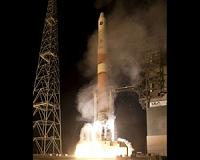 |
Vandenberg AFB, CA (SPX) Nov 12, 2010 For the 350th time in its illustrious 50-year program history, a Delta rocket launched from U.S. soil, adding another chapter to one of the most successful rocket launch programs in American history. The 350th mission was a United Launch Alliance Delta II rocket launching the fourth Italian-built Constellation of Small Satellites for Mediterranean Basin Observation (COSMO-SkyMed 4) satellite from Space Launch Complex-2. ULA successfully launched the first three COSMO-SkyMed satellites on Delta II vehicles June 7, 2007, Dec. 8, 2007, and Oct. 24, 2008. The mission was procured by Boeing Launch Services and was launched for the Italian Space Agency, the Italian Ministry of Defence and Thales Alenia Space. The first Delta launch took place on May 13, 1960. The Delta II used for this launch has demonstrated a 98.6 percent success rate and, while ULA launches one mission at a time, COSMO-SkyMed 4 marks the 93rd successful launch of a Delta II dating back to 1997. "This successful launch of the Cosmo-SkyMed-4 mission was the 350th Delta launch, which has provided an exceptional highlight to the year-long 50th anniversary celebration of the Delta program," said Jim Sponnick, ULA vice president, Mission Operations. "The Delta system has achieved an extremely impressive track record of mission success over the last five decades. "This achievement was made possible by the outstanding skills and hard work of our engineers and technicians along with the tremendous support we receive from our government, industry, and supplier mission partners. "The ULA team is very pleased to have successfully launched the fourth COSMO-SkyMed satellite for Boeing, the Italian Space Agency, Ministry of Defence and Thales Alenia Space." The ULA Delta II 7420-10 configuration vehicle featured a ULA first stage booster powered by a Pratt and Whitney Rocketdyne RS-27A main engine and four Alliant Techsystems (ATK) strap-on solid rocket boosters. An Aerojet AJ10-118K engine powered the second stage. The payload was encased by a 10-foot-diameter composite payload fairing. COSMO-SkyMed 4 is the final satellite in the initial constellation for this system. Each of the four satellites is equipped with a high-resolution Synthetic Aperture Radar operating in X-band. The overall objective of the program is global Earth observation and relevant data responding to the needs of the military and scientific community, as well as to the public demand for environmental control.
Share This Article With Planet Earth
Related Links - Launch Pad at Space-Travel.com
 NASA Selects Companies For Heavy-Lift Launch Vehicle Studies
NASA Selects Companies For Heavy-Lift Launch Vehicle StudiesWashington DC (SPX) Nov 11, 2010 NASA has selected 13 companies for negotiations leading to potential contract awards to conduct systems analysis and trade studies for evaluating heavy-lift launch vehicle system concepts, propulsion technologies, and affordability. The selected companies are: Aerojet General Corp., Rancho Cordova, Calif. Analytical Mechanics Associates, Huntsville, Ala. Andrews Space, Tu ... read more |
|
| The content herein, unless otherwise known to be public domain, are Copyright 1995-2010 - SpaceDaily. AFP and UPI Wire Stories are copyright Agence France-Presse and United Press International. ESA Portal Reports are copyright European Space Agency. All NASA sourced material is public domain. Additional copyrights may apply in whole or part to other bona fide parties. Advertising does not imply endorsement,agreement or approval of any opinions, statements or information provided by SpaceDaily on any Web page published or hosted by SpaceDaily. Privacy Statement |